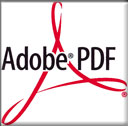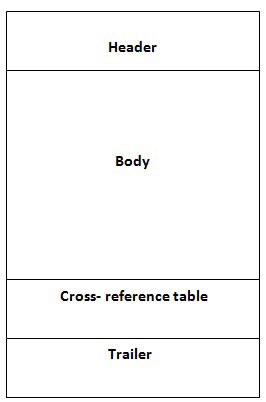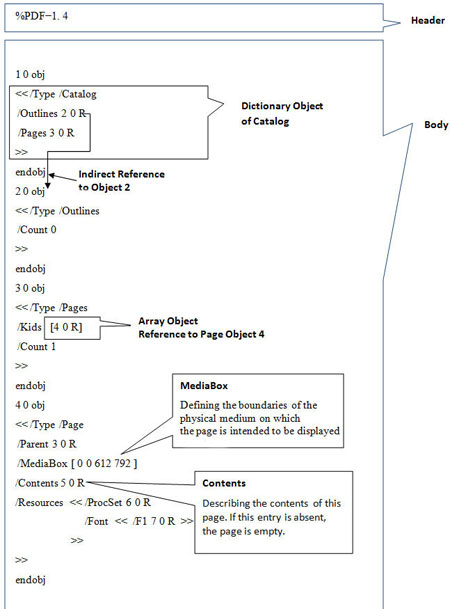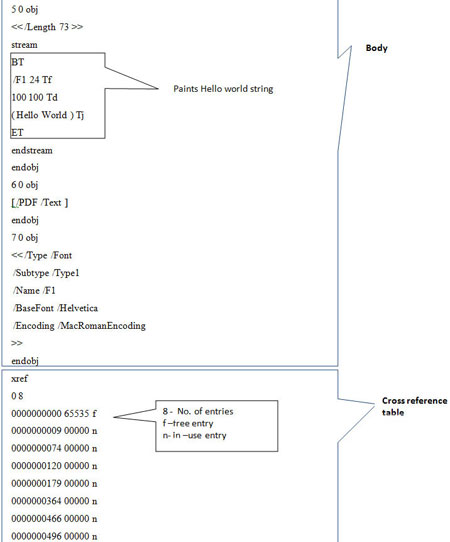| |
| |
| PDF Overview - Peering into the Internals of PDF |
| Author:
Ayush Anand |
| |
| |
| |
|
|
|
| |
| |
| |
|
|
| |
| |
|

|
Portable Document Format (PDF) is a file format for representing
documents in a manner independent of the application software,
hardware, and operating system used to create them and of the output
device on which they are to be displayed or printed. |
|
|
|
|
In this introductory article I will explain the internals of PDF
document, its structures and components with examples and
screenshots. It will help you understand intrinsics of PDF
document and will be more useful if you are into PDF malware analysis.
|
| |
| |
| |
|
PDF syntax consists of four main
components: |
- Objects
- File Structure
- Document Structure
- Content Stream
|
|
|
| |
| A PDF file consists primarily of objects, of which there are eight
types: |
- Boolean values, representing true or false
- Numbers include integer and real
- Strings
- Names
- Arrays, ordered collections of objects
- Dictionaries, collections of objects indexed by Names
- Streams, usually containing large amounts of data
- The null object denoted by keyword null
|
| I will explain more details about each of
these objects in detail in the following section. |
|
| |
| |
| |
| String objects can be represented in two
ways: |
- Literal Strings
- Hexadecimal Strings
|
| Literal Strings consists of any number of
characters between opening and closing parenthesis. |
| |
Example
(This is a string objects)
If string is too long then it can be
represented using backslash as shown below
(This is a very long\
String.)
Hexadecimal Strings consists of hexadecimal character
enclose with angel bracket
Example:
<A0C1D2E3F1> |
| |
| Here each pair of hexadecimal defines one
byte of string. |
| |
| |
| |
| |
| A names object is uniquely defined by
sequence of characters. Slash character(/) defined a name. |
| |
Example
/secsavvy
/SecSavvy
Both are different name.
/Sec#20Savvy
mean Sec Savvy 20 is hexadecimal value for white space.
Note: Pdf
is case-sensitive. |
| |
| |
| |
| |
| An array object is collection of objects.
PDF array object can be heterogeneous. It is defined with square
brackets. |
| |
Example
[1 (string) /Name 3.14] |
| |
| |
| |
| |
Dictionary object consists of pairs of
objects. The first element is key and the second is value.
The key must be name. A dictionary is written as a sequence of
key-value pairs enclosed in double angle brackets (<< … >>). |
| |
Example
<< /Type /Pages
/Kids [ 4 0 R ]
/Count 1
>>
Count is a
key and 1 is value. |
| |
| |
| |
| |
A stream object, like a string object, is
a sequence of bytes. Stream can be of unlimited length, whereas a
string is subject to an implementation limit. For this reason,
objects with potentially large amounts of data, such as images and
page descriptions, are represented as streams.
A stream
consists of a dictionary followed by zero or more bytes bracketed
between the keywords stream and endstream: |
| |
dictionary
stream
... Zero or more bytes ...
endstream |
| |
| |
| |
| |
| Objects may be labeled so that they can be
referred to by other objects. A labeled object is called an indirect
object. |
| |
Example
Consider this object
obj and endobj is a keyword.
10
0 obj
(SecSavvy String)
endobj
This object defined a string
of object number 10.
This object can be referred in a file by
indirect reference as
10 0 R |
| |
| |
| |
| |
A filter is an optional part of the
specification of a stream, indicating how the data in the stream
must be decoded before it is used. For example, if a stream has an
ASCIIHexDecode filter, an application reading the data in that
stream will transform the ASCII hexadecimal-encoded data in the
stream into binary data.
For data encoded using LZW and ASCII
base-85 encoding (in that order) can be decoded using the following
entry in the stream dictionary:
/Filter [
/ASCII85Decode /LZWDecode ] |
| |
Example
1 0 obj
<< /Length 534 /Filter [ /ASCII85Decode /LZWDecode ]>>
stream
J..)6T`?p&<!J9%_[umg"B7/Z7KNXbN'S+,*Q/&"OLT'FLIDK#!n`$"<Atdi`\Vn%b%)&'cA*VnK\CJY(sF>c!Jnl@RM]WM;jjH6Gnc75idkL5]+cPZKEBPWdR>FF(kj1_R%W_d&/jS!;iuad7h?[L-F$+]]0A3Ck*$I0KZ?;<)CJtqi65XbVc3\n5ua:Q/=0$W<#N3U;H,MQKqfg1?:lUpR;6oN[C2E4ZNr8Udn.'p+?#X+1>0Kuk$bCDF/(3fL5]Oq)^kJZ!C2H1'TO]Rl?Q:&’<5&iP!$Rq;BXRecDN[IJB`,)o8XJOSJ9sDS]hQ;Rj@!ND)bD_q&C\g:inYC%)&u#:u,M6Bm%IY!Kb1+”:aAa’S`ViJglLb8<W9k6Yl\\0McJQkDeLWdPN?9A’jX*al>iG1p&i;eVoK&juJHs9%;Xomop”5KatWRT”JQ#qYuL,JD?M$0QP)lKn06l1apKDC@\qJ4B!!(5m+j.7F790m(Vj88l8Q:_CZ(Gm1%X\N1&u!FKHMB~>
endstream
endobj |
| |
| Here is the list of standard filters |
- ASCIIHexDecode
- ASCII85Decode
- LZWDecode
- FlateDecode
- RunLengthDecode
- CCITTFaxDecode
- JBIG2Decode
- DCTDecode
- JPXDecode
- Crypt
|
| |
| |
| |
| PDF file consists of 4 main elements: |
- PDF header identifying the PDF specification.
- A body containing the objects that make up the
document contained in the file
- A cross-reference table containing information about
the indirect objects in the file
- A trailer giving the location of the cross-reference
table and of certain special objects within the body of the
file.
|
| |
 |
| |
| |
| |
| |
The cross-reference table contains
information that permits random access to indirect objects within
the file so that the entire file need not be read to locate any
particular object. The table contains a one-line entry for each
indirect object, specifying the location of that object within the
body of the file.
Each cross-reference section begins with a
line containing the keyword xref. Following this line are one or
more cross-reference subsections, which may appear in any order.
Each cross-reference subsection contains entries for a
contiguous range of object numbers. The subsection begins with a
line containing two numbers separated by a space: the object number
of the first object in this subsection and the number of entries in
the subsection. For example, the line
0 8
introduces a subsection containing five objects numbered
consecutively from 0 to 8. |
| |
xref
0 8
0000000000 65535 f
0000000009 00000 n
0000000074 00000 n
0000000120 00000 n
0000000179 00000 n
0000000364 00000 n
0000000466 00000 n
0000000496 00000 n |
| |
0000000009 is 10 digit byte offset in the
case of in-use entry , giving the number of bytes from the beginning
of the file to the beginning of the object.
0000000000 is the
10-digit object number of the next free object int the case of free
entry |
| |
| |
| |
| |
| Here are the series of screenshots which
shows different parts of sample PDF document. |
| |
 |
| |
 |
| |
 |
| |
| |
| |
| |
|
|
| |
| |
| |
This article explains in brief internals
of PDF document, its structures, components with examples and
detailed screenshots. Hope this article will help you in the
malware research work revolviing around PDF documents.
Though it is enough for beginners but advanced users are advised
read through reference white paper for more granular details. |
| |
| |
| |
|
|
|
| |
| |
| |
| |
| |